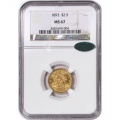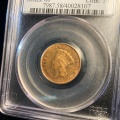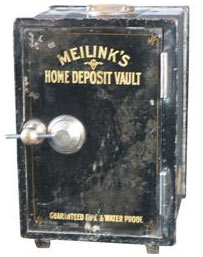September 2022 - Week 4 Edition
Gold and Silver Fighting Strong Dollar
Gold and silver are down due to another strong surge in the U.S. dollar, due to the aggressive rate-raising regimen Federal Reserve Chairman Jerome Powell announced after this past week’s meeting of the Federal Open Market Committee (FOMC). In essence, he said the Fed would raise rates again (probably by 0.75%) just a week before the mid-term election in November, and then raise rates another 0.50% before Christmas in order to match current short-term (two-year) Treasury rates of 4.4%. (In the last week, 2-year rates rose from 3.9% to 4.4% and 10-year rates rose from 3.5% to almost 4.0%)
Far from his dovish tones of last year, Powell now says, “Inflation is running too hot. You don’t need to know much more than that…This committee is committed to getting to a meaningful, restrictive stance of policy and staying there until we feel confident that inflation is coming down.”
This policy, combined with $95 billion per month in quantitative tightening (QT), the opposite of money-printing, has caused mortgage rates and some short-term Treasury rates to rise to their highest levels since 2010. This super-aggressive posture sent the stock market down sharply last week and it also sent the market down almost 20% in the fourth quarter of 2018, when Powell raised rates twice.
Sharply higher interest rates have an immediate impact in freezing the once-hot real estate market but it takes six months or more for a rate increase to work its way through the economy and cause a slowdown in retail sales and other key economic factors impacting Gross Domestic Product (GDP). It seems like the Fed may be acting “too fast” in being “too tight” after being “too easy for too long” in previous years. They are now fighting stubborn inflation, which they caused and once called “transitory” (short-lived).
Most Currencies Are Down – Meaning Gold is UP in Most Other Currencies
Gold traded in the $1,670s before the Fed announcement, but it soon dropped to its lowest since April 3, 2020, as the dollar shot up on expectations that foreign investors would park more funds in the dollar for higher interest than the euro, Japanese yen or British pound can offer.
As a result, the euro is now down to 96-cents from over $1.13 at the start of the year (-15.2%), and the British pound is at a 36-year low of $1.07, down from $1.35 at the start of the year (-20.7%). The Japanese yen is also down over 20% to the U.S dollar so far this year. What this means is that although gold is down 10% in dollar terms, gold is up about 5% in euro terms and about 10% in pounds and yen.
Even the Chinese yuan is down 3.7% this month and down double digits to the dollar this year, nearing 2008 lows. This caused Beijing’s central bank to step in and shore up the yuan, while cutting way back on their expensive “Belt and Road initiative.” Part of the reason the euro, yen and yuan are weakening is that their debt-to-GDP ratios are even higher than the lofty rates in the U.S. and these higher interest rates around the world are hurting their economies even more, as they try to service their sky-high deficits.
As the entire globe must now begin to service multi-trillion-dollar deficits at average 4% rates instead of zero to 1%, they will begin to feel the pinch of high rates pushing their deficits trillions of dollars higher. Over time, this will benefit the gold trader, as most nations will opt to print more money, to inflate their currency, to “monetize the debt” as the least painful way to inflate their way out of their deficit spending.
As Hurricane Ian Hits America, Consider Your “Green” Escape Plan
We know many friends in “hurricane country” and hurricanes sometimes hit our homes near Beaumont, Texas. Don’t send any packages to Florida this week. They won’t get there. We wish our friends in Florida and Georgia the best, but I hope you’re not counting on escaping the storm in an electric car or riding out the storm with a “green” generator. How would you like to be on the freeway trying to escape the storm’s path when the average speed is under 10 miles per hour, the exits are few and far between, and your electricity is running low? If you are at home, what generators run on “green” energy? Is there any such thing as a green generator? It isn’t feasible. They run on fossil-fuels. This is a time when theory meets reality. In time, it will be nice to transition to electricity but we must first have the sufficient grid capacity, refueling stations, battery components and 100 other vital support systems we don’t have yet.
Last week, long before the hurricane posed imminent danger, The Wall Street Journal published an excellent review of some the roadblocks to a quick transition to EVs (“Electric-Car Demand Pushes Lithium Prices to Records,” September 21). First, the Biden administration’s transition to electric vehicles (EVs) has created long waiting lists that are frustrating many sincere buyers, since prices are being raised thousands of dollars while they wait, so many buyers are now wondering if they can still afford an EV.
Secondly, many critical parts are in short supply and very expensive, especially lithium-ion batteries. Lithium cost under $10,000 per metric ton when Biden took office, but the price is now over $70,000 per ton. There are also severe supply chain problems for other EV components and semiconductor chips.
Recently, I told you about a friend of a friend who had a failed EV battery pack after just 23,000 miles. It was in service for five weeks. Well, he lives in Floria, and that car is still in service now after seven weeks. The owner is disgusted and thinks that EVs are just “toys for rich people in coastal cities.” He is happy he also has a gasoline-fueled car to escape the winds of Florida before Hurricane Ian hits. He told my friend, “I would hate to get stuck on a long road trip with an electric car that failed!” Amen!

Important Disclosure Notification: All statements, opinions, pricing, and ideas herein are believed to be reliable, truthful and accurate to the best of the Publisher's knowledge at this time. They are not guaranteed in any way by anybody and are subject to change over time. The Publisher disclaims and is not liable for any claims or losses which may be incurred by third parties while relying on information published herein. Individuals should not look at this publication as giving finance or investment advice or information for their individual suitability. All readers are advised to independently verify all representations made herein or by its representatives for your individual suitability before making your investment or collecting decisions. Arbitration: This company strives to handle customer complaint issues directly with customer in an expeditious manner. In the event an amicable resolution cannot be reached, you agree to accept binding arbitration. Any dispute, controversy, claim or disagreement arising out of or relating to transactions between you and this company shall be resolved by binding arbitration pursuant to the Federal Arbitration Act and conducted in Beaumont, Jefferson County, Texas. It is understood that the parties waive any right to a jury trial. Judgment upon the award rendered by the Arbitrator may be entered in any court having jurisdiction thereof. Reproduction or quotation of this newsletter is prohibited without written permission of the Publisher.













































